Comprehensive Report: Environmental Systems and Climate Change
VerifiedAdded on 2021/06/18
|10
|2701
|22
Report
AI Summary
This report provides a detailed analysis of environmental systems and climate change, focusing on the anthropogenic influences and the scientific consensus on global warming. It explores the role of greenhouse gases, the impact of human activities like industrial emissions and deforestation, and the evidence presented in IPCC reports. The report delves into climate change science, including detection, attribution, and policy, while also examining climate sensitivity and the use of climate change models. It discusses the impacts on the biosphere, including species extinction and coral bleaching, and addresses the arguments of climate change skeptics. The conclusion emphasizes the far-reaching consequences of climate change on humans, animals, and the plant kingdom, highlighting the need for action.
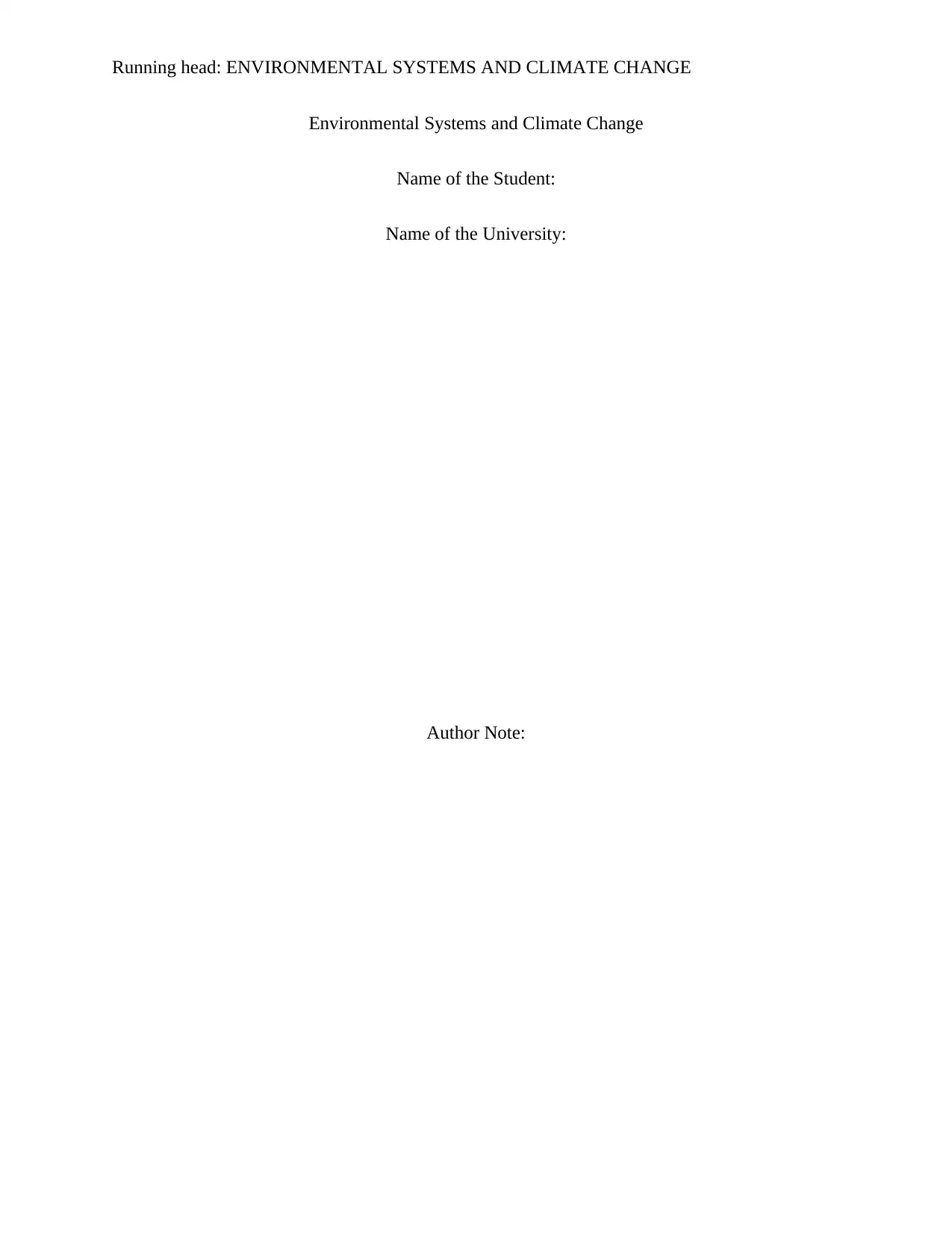
Running head: ENVIRONMENTAL SYSTEMS AND CLIMATE CHANGE
Environmental Systems and Climate Change
Name of the Student:
Name of the University:
Author Note:
Environmental Systems and Climate Change
Name of the Student:
Name of the University:
Author Note:
Paraphrase This Document
Need a fresh take? Get an instant paraphrase of this document with our AI Paraphraser
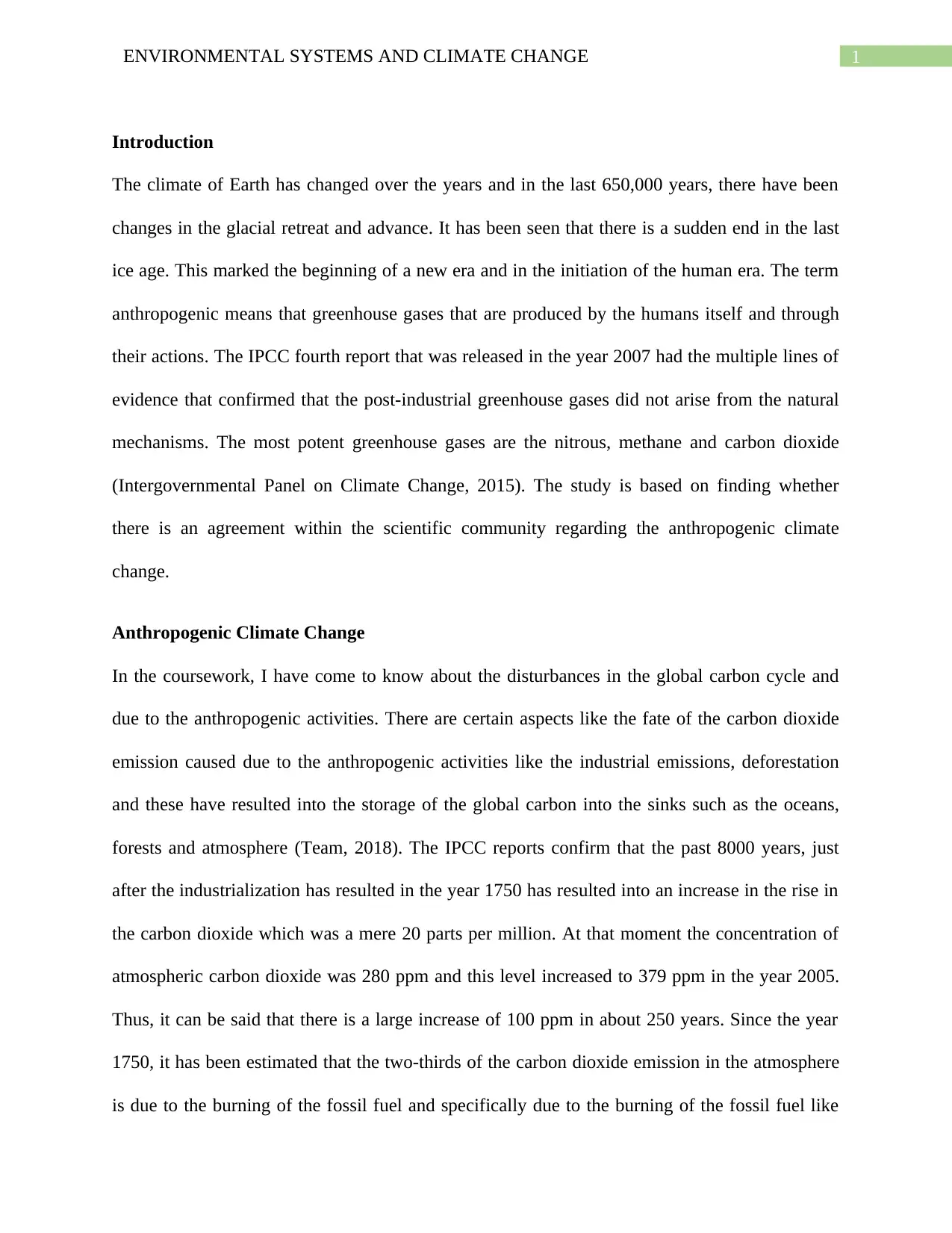
1ENVIRONMENTAL SYSTEMS AND CLIMATE CHANGE
Introduction
The climate of Earth has changed over the years and in the last 650,000 years, there have been
changes in the glacial retreat and advance. It has been seen that there is a sudden end in the last
ice age. This marked the beginning of a new era and in the initiation of the human era. The term
anthropogenic means that greenhouse gases that are produced by the humans itself and through
their actions. The IPCC fourth report that was released in the year 2007 had the multiple lines of
evidence that confirmed that the post-industrial greenhouse gases did not arise from the natural
mechanisms. The most potent greenhouse gases are the nitrous, methane and carbon dioxide
(Intergovernmental Panel on Climate Change, 2015). The study is based on finding whether
there is an agreement within the scientific community regarding the anthropogenic climate
change.
Anthropogenic Climate Change
In the coursework, I have come to know about the disturbances in the global carbon cycle and
due to the anthropogenic activities. There are certain aspects like the fate of the carbon dioxide
emission caused due to the anthropogenic activities like the industrial emissions, deforestation
and these have resulted into the storage of the global carbon into the sinks such as the oceans,
forests and atmosphere (Team, 2018). The IPCC reports confirm that the past 8000 years, just
after the industrialization has resulted in the year 1750 has resulted into an increase in the rise in
the carbon dioxide which was a mere 20 parts per million. At that moment the concentration of
atmospheric carbon dioxide was 280 ppm and this level increased to 379 ppm in the year 2005.
Thus, it can be said that there is a large increase of 100 ppm in about 250 years. Since the year
1750, it has been estimated that the two-thirds of the carbon dioxide emission in the atmosphere
is due to the burning of the fossil fuel and specifically due to the burning of the fossil fuel like
Introduction
The climate of Earth has changed over the years and in the last 650,000 years, there have been
changes in the glacial retreat and advance. It has been seen that there is a sudden end in the last
ice age. This marked the beginning of a new era and in the initiation of the human era. The term
anthropogenic means that greenhouse gases that are produced by the humans itself and through
their actions. The IPCC fourth report that was released in the year 2007 had the multiple lines of
evidence that confirmed that the post-industrial greenhouse gases did not arise from the natural
mechanisms. The most potent greenhouse gases are the nitrous, methane and carbon dioxide
(Intergovernmental Panel on Climate Change, 2015). The study is based on finding whether
there is an agreement within the scientific community regarding the anthropogenic climate
change.
Anthropogenic Climate Change
In the coursework, I have come to know about the disturbances in the global carbon cycle and
due to the anthropogenic activities. There are certain aspects like the fate of the carbon dioxide
emission caused due to the anthropogenic activities like the industrial emissions, deforestation
and these have resulted into the storage of the global carbon into the sinks such as the oceans,
forests and atmosphere (Team, 2018). The IPCC reports confirm that the past 8000 years, just
after the industrialization has resulted in the year 1750 has resulted into an increase in the rise in
the carbon dioxide which was a mere 20 parts per million. At that moment the concentration of
atmospheric carbon dioxide was 280 ppm and this level increased to 379 ppm in the year 2005.
Thus, it can be said that there is a large increase of 100 ppm in about 250 years. Since the year
1750, it has been estimated that the two-thirds of the carbon dioxide emission in the atmosphere
is due to the burning of the fossil fuel and specifically due to the burning of the fossil fuel like
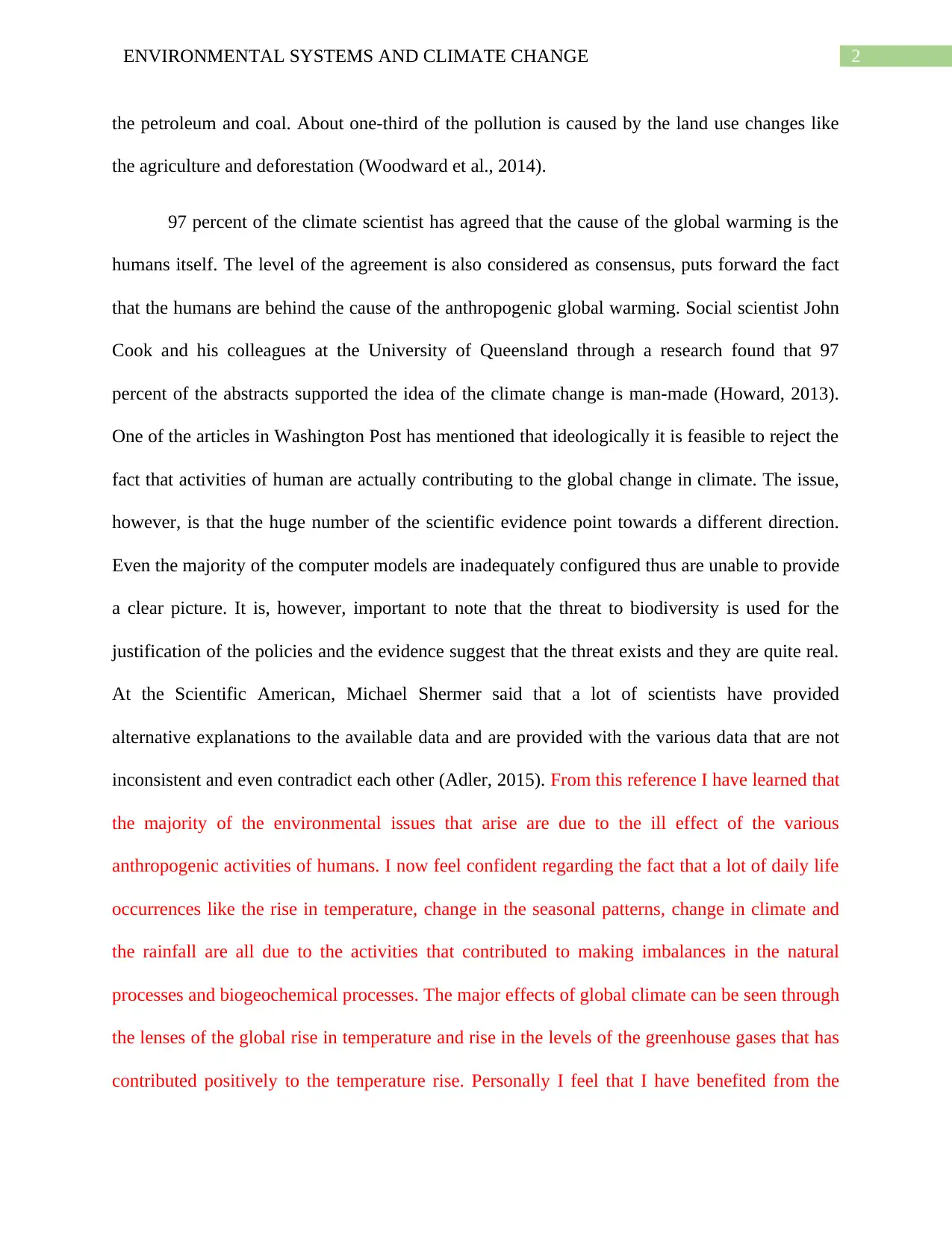
2ENVIRONMENTAL SYSTEMS AND CLIMATE CHANGE
the petroleum and coal. About one-third of the pollution is caused by the land use changes like
the agriculture and deforestation (Woodward et al., 2014).
97 percent of the climate scientist has agreed that the cause of the global warming is the
humans itself. The level of the agreement is also considered as consensus, puts forward the fact
that the humans are behind the cause of the anthropogenic global warming. Social scientist John
Cook and his colleagues at the University of Queensland through a research found that 97
percent of the abstracts supported the idea of the climate change is man-made (Howard, 2013).
One of the articles in Washington Post has mentioned that ideologically it is feasible to reject the
fact that activities of human are actually contributing to the global change in climate. The issue,
however, is that the huge number of the scientific evidence point towards a different direction.
Even the majority of the computer models are inadequately configured thus are unable to provide
a clear picture. It is, however, important to note that the threat to biodiversity is used for the
justification of the policies and the evidence suggest that the threat exists and they are quite real.
At the Scientific American, Michael Shermer said that a lot of scientists have provided
alternative explanations to the available data and are provided with the various data that are not
inconsistent and even contradict each other (Adler, 2015). From this reference I have learned that
the majority of the environmental issues that arise are due to the ill effect of the various
anthropogenic activities of humans. I now feel confident regarding the fact that a lot of daily life
occurrences like the rise in temperature, change in the seasonal patterns, change in climate and
the rainfall are all due to the activities that contributed to making imbalances in the natural
processes and biogeochemical processes. The major effects of global climate can be seen through
the lenses of the global rise in temperature and rise in the levels of the greenhouse gases that has
contributed positively to the temperature rise. Personally I feel that I have benefited from the
the petroleum and coal. About one-third of the pollution is caused by the land use changes like
the agriculture and deforestation (Woodward et al., 2014).
97 percent of the climate scientist has agreed that the cause of the global warming is the
humans itself. The level of the agreement is also considered as consensus, puts forward the fact
that the humans are behind the cause of the anthropogenic global warming. Social scientist John
Cook and his colleagues at the University of Queensland through a research found that 97
percent of the abstracts supported the idea of the climate change is man-made (Howard, 2013).
One of the articles in Washington Post has mentioned that ideologically it is feasible to reject the
fact that activities of human are actually contributing to the global change in climate. The issue,
however, is that the huge number of the scientific evidence point towards a different direction.
Even the majority of the computer models are inadequately configured thus are unable to provide
a clear picture. It is, however, important to note that the threat to biodiversity is used for the
justification of the policies and the evidence suggest that the threat exists and they are quite real.
At the Scientific American, Michael Shermer said that a lot of scientists have provided
alternative explanations to the available data and are provided with the various data that are not
inconsistent and even contradict each other (Adler, 2015). From this reference I have learned that
the majority of the environmental issues that arise are due to the ill effect of the various
anthropogenic activities of humans. I now feel confident regarding the fact that a lot of daily life
occurrences like the rise in temperature, change in the seasonal patterns, change in climate and
the rainfall are all due to the activities that contributed to making imbalances in the natural
processes and biogeochemical processes. The major effects of global climate can be seen through
the lenses of the global rise in temperature and rise in the levels of the greenhouse gases that has
contributed positively to the temperature rise. Personally I feel that I have benefited from the
⊘ This is a preview!⊘
Do you want full access?
Subscribe today to unlock all pages.

Trusted by 1+ million students worldwide
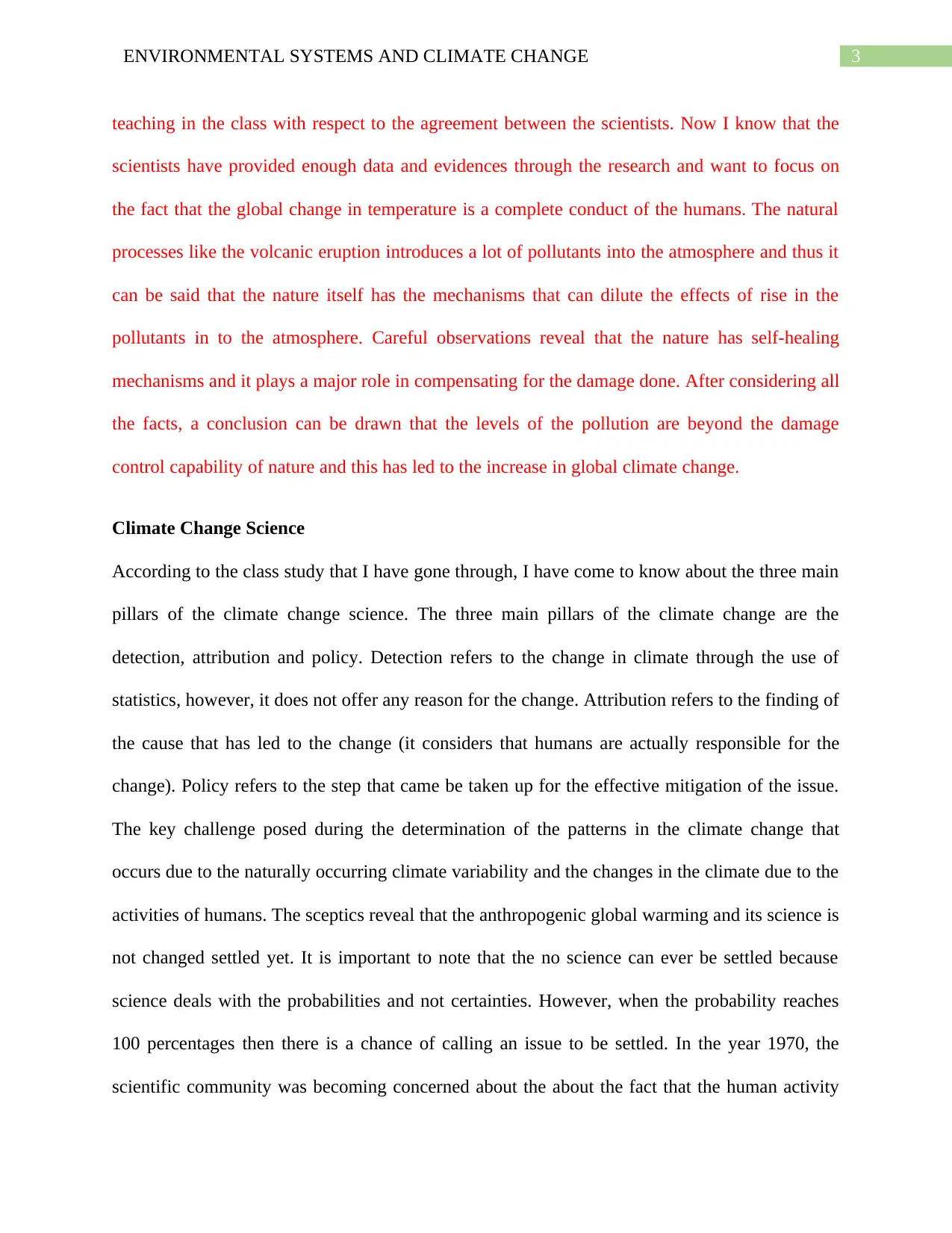
3ENVIRONMENTAL SYSTEMS AND CLIMATE CHANGE
teaching in the class with respect to the agreement between the scientists. Now I know that the
scientists have provided enough data and evidences through the research and want to focus on
the fact that the global change in temperature is a complete conduct of the humans. The natural
processes like the volcanic eruption introduces a lot of pollutants into the atmosphere and thus it
can be said that the nature itself has the mechanisms that can dilute the effects of rise in the
pollutants in to the atmosphere. Careful observations reveal that the nature has self-healing
mechanisms and it plays a major role in compensating for the damage done. After considering all
the facts, a conclusion can be drawn that the levels of the pollution are beyond the damage
control capability of nature and this has led to the increase in global climate change.
Climate Change Science
According to the class study that I have gone through, I have come to know about the three main
pillars of the climate change science. The three main pillars of the climate change are the
detection, attribution and policy. Detection refers to the change in climate through the use of
statistics, however, it does not offer any reason for the change. Attribution refers to the finding of
the cause that has led to the change (it considers that humans are actually responsible for the
change). Policy refers to the step that came be taken up for the effective mitigation of the issue.
The key challenge posed during the determination of the patterns in the climate change that
occurs due to the naturally occurring climate variability and the changes in the climate due to the
activities of humans. The sceptics reveal that the anthropogenic global warming and its science is
not changed settled yet. It is important to note that the no science can ever be settled because
science deals with the probabilities and not certainties. However, when the probability reaches
100 percentages then there is a chance of calling an issue to be settled. In the year 1970, the
scientific community was becoming concerned about the about the fact that the human activity
teaching in the class with respect to the agreement between the scientists. Now I know that the
scientists have provided enough data and evidences through the research and want to focus on
the fact that the global change in temperature is a complete conduct of the humans. The natural
processes like the volcanic eruption introduces a lot of pollutants into the atmosphere and thus it
can be said that the nature itself has the mechanisms that can dilute the effects of rise in the
pollutants in to the atmosphere. Careful observations reveal that the nature has self-healing
mechanisms and it plays a major role in compensating for the damage done. After considering all
the facts, a conclusion can be drawn that the levels of the pollution are beyond the damage
control capability of nature and this has led to the increase in global climate change.
Climate Change Science
According to the class study that I have gone through, I have come to know about the three main
pillars of the climate change science. The three main pillars of the climate change are the
detection, attribution and policy. Detection refers to the change in climate through the use of
statistics, however, it does not offer any reason for the change. Attribution refers to the finding of
the cause that has led to the change (it considers that humans are actually responsible for the
change). Policy refers to the step that came be taken up for the effective mitigation of the issue.
The key challenge posed during the determination of the patterns in the climate change that
occurs due to the naturally occurring climate variability and the changes in the climate due to the
activities of humans. The sceptics reveal that the anthropogenic global warming and its science is
not changed settled yet. It is important to note that the no science can ever be settled because
science deals with the probabilities and not certainties. However, when the probability reaches
100 percentages then there is a chance of calling an issue to be settled. In the year 1970, the
scientific community was becoming concerned about the about the fact that the human activity
Paraphrase This Document
Need a fresh take? Get an instant paraphrase of this document with our AI Paraphraser
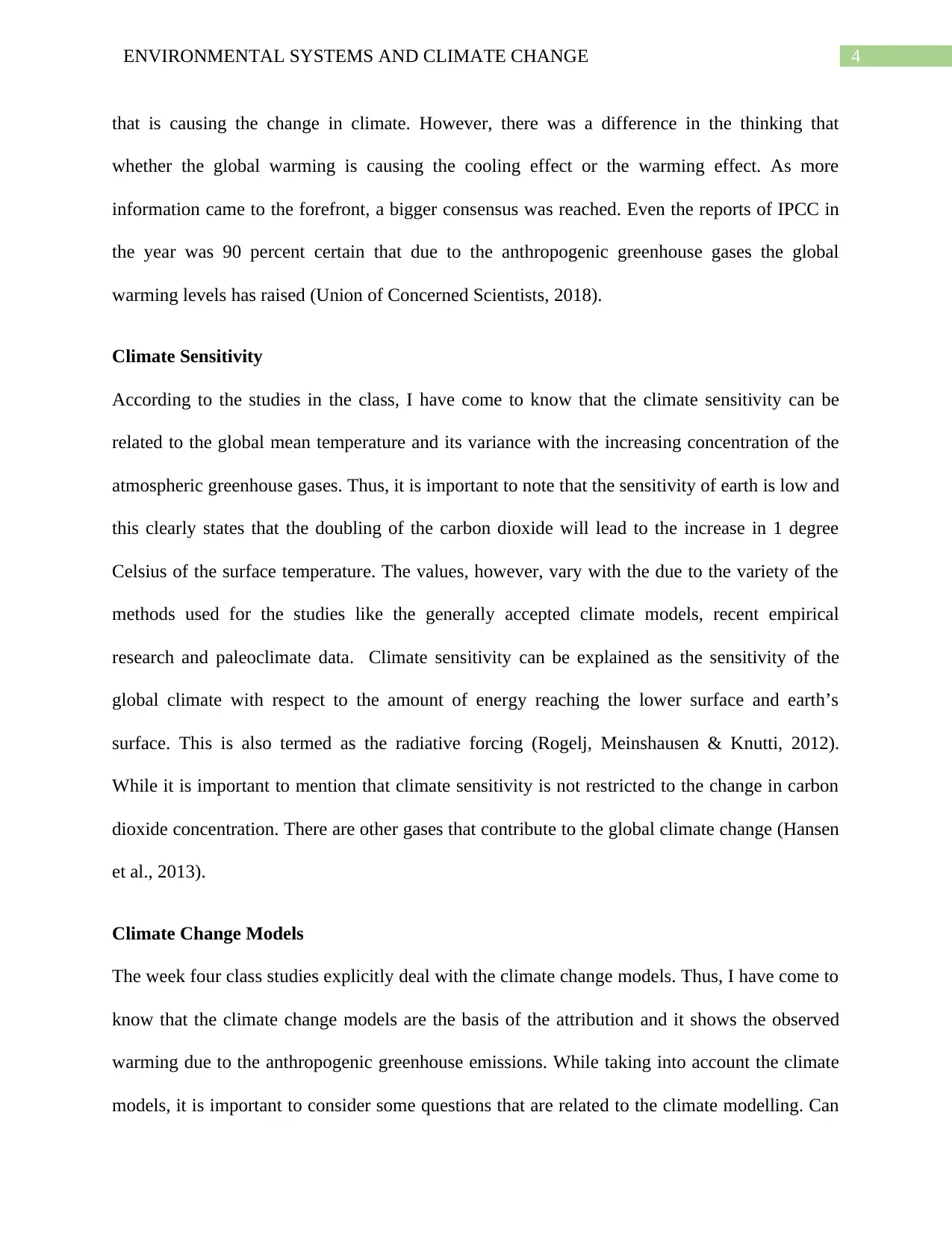
4ENVIRONMENTAL SYSTEMS AND CLIMATE CHANGE
that is causing the change in climate. However, there was a difference in the thinking that
whether the global warming is causing the cooling effect or the warming effect. As more
information came to the forefront, a bigger consensus was reached. Even the reports of IPCC in
the year was 90 percent certain that due to the anthropogenic greenhouse gases the global
warming levels has raised (Union of Concerned Scientists, 2018).
Climate Sensitivity
According to the studies in the class, I have come to know that the climate sensitivity can be
related to the global mean temperature and its variance with the increasing concentration of the
atmospheric greenhouse gases. Thus, it is important to note that the sensitivity of earth is low and
this clearly states that the doubling of the carbon dioxide will lead to the increase in 1 degree
Celsius of the surface temperature. The values, however, vary with the due to the variety of the
methods used for the studies like the generally accepted climate models, recent empirical
research and paleoclimate data. Climate sensitivity can be explained as the sensitivity of the
global climate with respect to the amount of energy reaching the lower surface and earth’s
surface. This is also termed as the radiative forcing (Rogelj, Meinshausen & Knutti, 2012).
While it is important to mention that climate sensitivity is not restricted to the change in carbon
dioxide concentration. There are other gases that contribute to the global climate change (Hansen
et al., 2013).
Climate Change Models
The week four class studies explicitly deal with the climate change models. Thus, I have come to
know that the climate change models are the basis of the attribution and it shows the observed
warming due to the anthropogenic greenhouse emissions. While taking into account the climate
models, it is important to consider some questions that are related to the climate modelling. Can
that is causing the change in climate. However, there was a difference in the thinking that
whether the global warming is causing the cooling effect or the warming effect. As more
information came to the forefront, a bigger consensus was reached. Even the reports of IPCC in
the year was 90 percent certain that due to the anthropogenic greenhouse gases the global
warming levels has raised (Union of Concerned Scientists, 2018).
Climate Sensitivity
According to the studies in the class, I have come to know that the climate sensitivity can be
related to the global mean temperature and its variance with the increasing concentration of the
atmospheric greenhouse gases. Thus, it is important to note that the sensitivity of earth is low and
this clearly states that the doubling of the carbon dioxide will lead to the increase in 1 degree
Celsius of the surface temperature. The values, however, vary with the due to the variety of the
methods used for the studies like the generally accepted climate models, recent empirical
research and paleoclimate data. Climate sensitivity can be explained as the sensitivity of the
global climate with respect to the amount of energy reaching the lower surface and earth’s
surface. This is also termed as the radiative forcing (Rogelj, Meinshausen & Knutti, 2012).
While it is important to mention that climate sensitivity is not restricted to the change in carbon
dioxide concentration. There are other gases that contribute to the global climate change (Hansen
et al., 2013).
Climate Change Models
The week four class studies explicitly deal with the climate change models. Thus, I have come to
know that the climate change models are the basis of the attribution and it shows the observed
warming due to the anthropogenic greenhouse emissions. While taking into account the climate
models, it is important to consider some questions that are related to the climate modelling. Can
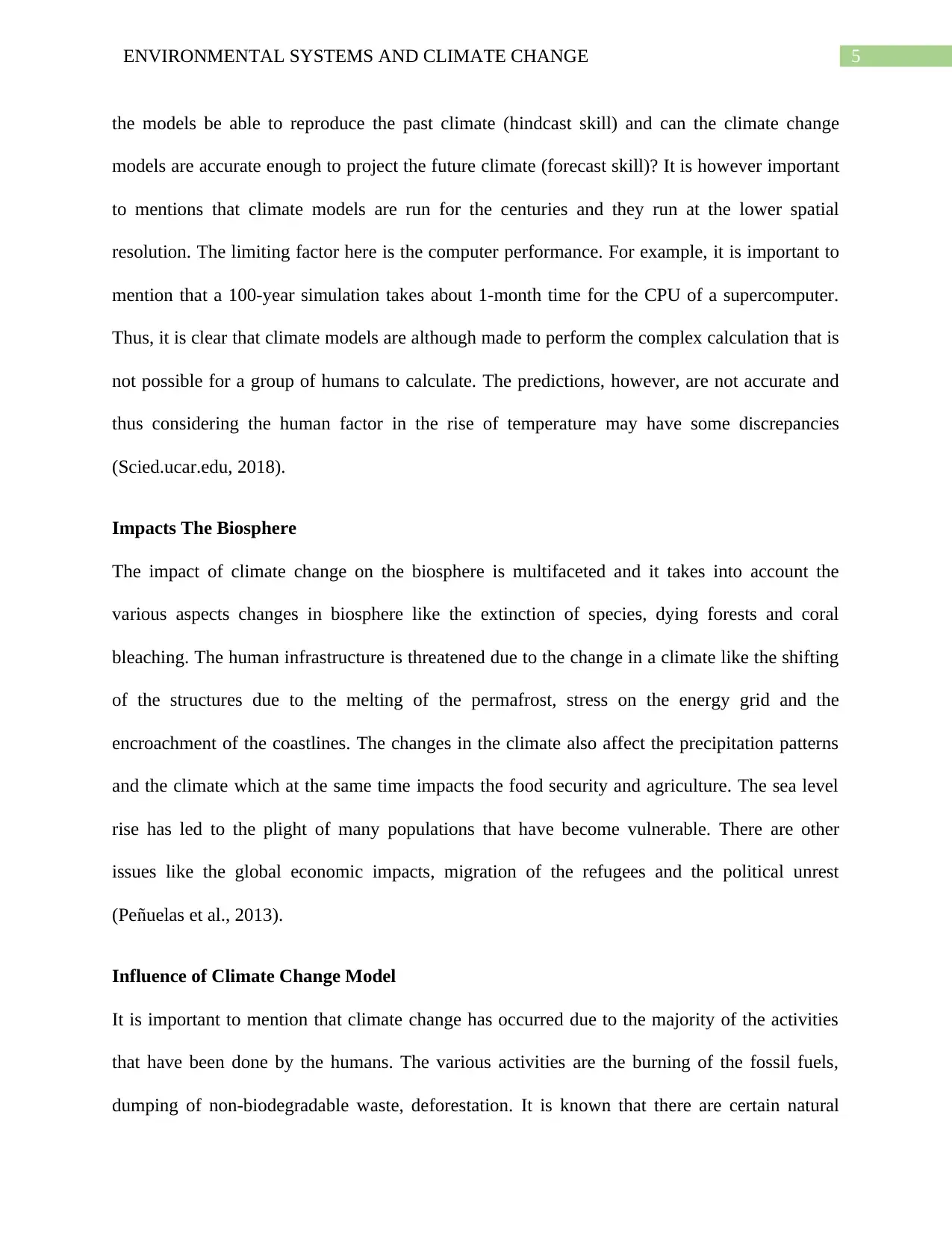
5ENVIRONMENTAL SYSTEMS AND CLIMATE CHANGE
the models be able to reproduce the past climate (hindcast skill) and can the climate change
models are accurate enough to project the future climate (forecast skill)? It is however important
to mentions that climate models are run for the centuries and they run at the lower spatial
resolution. The limiting factor here is the computer performance. For example, it is important to
mention that a 100-year simulation takes about 1-month time for the CPU of a supercomputer.
Thus, it is clear that climate models are although made to perform the complex calculation that is
not possible for a group of humans to calculate. The predictions, however, are not accurate and
thus considering the human factor in the rise of temperature may have some discrepancies
(Scied.ucar.edu, 2018).
Impacts The Biosphere
The impact of climate change on the biosphere is multifaceted and it takes into account the
various aspects changes in biosphere like the extinction of species, dying forests and coral
bleaching. The human infrastructure is threatened due to the change in a climate like the shifting
of the structures due to the melting of the permafrost, stress on the energy grid and the
encroachment of the coastlines. The changes in the climate also affect the precipitation patterns
and the climate which at the same time impacts the food security and agriculture. The sea level
rise has led to the plight of many populations that have become vulnerable. There are other
issues like the global economic impacts, migration of the refugees and the political unrest
(Peñuelas et al., 2013).
Influence of Climate Change Model
It is important to mention that climate change has occurred due to the majority of the activities
that have been done by the humans. The various activities are the burning of the fossil fuels,
dumping of non-biodegradable waste, deforestation. It is known that there are certain natural
the models be able to reproduce the past climate (hindcast skill) and can the climate change
models are accurate enough to project the future climate (forecast skill)? It is however important
to mentions that climate models are run for the centuries and they run at the lower spatial
resolution. The limiting factor here is the computer performance. For example, it is important to
mention that a 100-year simulation takes about 1-month time for the CPU of a supercomputer.
Thus, it is clear that climate models are although made to perform the complex calculation that is
not possible for a group of humans to calculate. The predictions, however, are not accurate and
thus considering the human factor in the rise of temperature may have some discrepancies
(Scied.ucar.edu, 2018).
Impacts The Biosphere
The impact of climate change on the biosphere is multifaceted and it takes into account the
various aspects changes in biosphere like the extinction of species, dying forests and coral
bleaching. The human infrastructure is threatened due to the change in a climate like the shifting
of the structures due to the melting of the permafrost, stress on the energy grid and the
encroachment of the coastlines. The changes in the climate also affect the precipitation patterns
and the climate which at the same time impacts the food security and agriculture. The sea level
rise has led to the plight of many populations that have become vulnerable. There are other
issues like the global economic impacts, migration of the refugees and the political unrest
(Peñuelas et al., 2013).
Influence of Climate Change Model
It is important to mention that climate change has occurred due to the majority of the activities
that have been done by the humans. The various activities are the burning of the fossil fuels,
dumping of non-biodegradable waste, deforestation. It is known that there are certain natural
⊘ This is a preview!⊘
Do you want full access?
Subscribe today to unlock all pages.

Trusted by 1+ million students worldwide
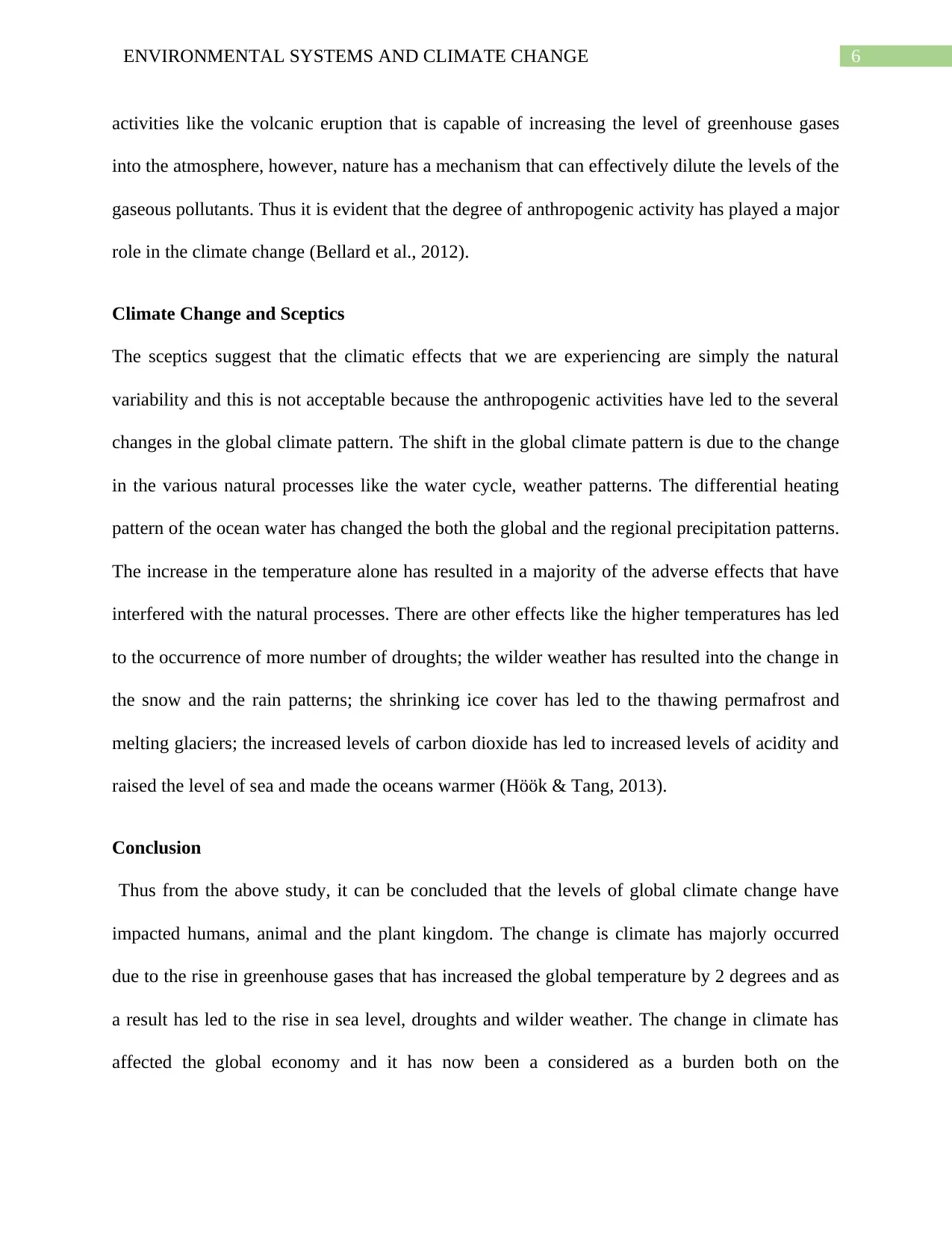
6ENVIRONMENTAL SYSTEMS AND CLIMATE CHANGE
activities like the volcanic eruption that is capable of increasing the level of greenhouse gases
into the atmosphere, however, nature has a mechanism that can effectively dilute the levels of the
gaseous pollutants. Thus it is evident that the degree of anthropogenic activity has played a major
role in the climate change (Bellard et al., 2012).
Climate Change and Sceptics
The sceptics suggest that the climatic effects that we are experiencing are simply the natural
variability and this is not acceptable because the anthropogenic activities have led to the several
changes in the global climate pattern. The shift in the global climate pattern is due to the change
in the various natural processes like the water cycle, weather patterns. The differential heating
pattern of the ocean water has changed the both the global and the regional precipitation patterns.
The increase in the temperature alone has resulted in a majority of the adverse effects that have
interfered with the natural processes. There are other effects like the higher temperatures has led
to the occurrence of more number of droughts; the wilder weather has resulted into the change in
the snow and the rain patterns; the shrinking ice cover has led to the thawing permafrost and
melting glaciers; the increased levels of carbon dioxide has led to increased levels of acidity and
raised the level of sea and made the oceans warmer (Höök & Tang, 2013).
Conclusion
Thus from the above study, it can be concluded that the levels of global climate change have
impacted humans, animal and the plant kingdom. The change is climate has majorly occurred
due to the rise in greenhouse gases that has increased the global temperature by 2 degrees and as
a result has led to the rise in sea level, droughts and wilder weather. The change in climate has
affected the global economy and it has now been a considered as a burden both on the
activities like the volcanic eruption that is capable of increasing the level of greenhouse gases
into the atmosphere, however, nature has a mechanism that can effectively dilute the levels of the
gaseous pollutants. Thus it is evident that the degree of anthropogenic activity has played a major
role in the climate change (Bellard et al., 2012).
Climate Change and Sceptics
The sceptics suggest that the climatic effects that we are experiencing are simply the natural
variability and this is not acceptable because the anthropogenic activities have led to the several
changes in the global climate pattern. The shift in the global climate pattern is due to the change
in the various natural processes like the water cycle, weather patterns. The differential heating
pattern of the ocean water has changed the both the global and the regional precipitation patterns.
The increase in the temperature alone has resulted in a majority of the adverse effects that have
interfered with the natural processes. There are other effects like the higher temperatures has led
to the occurrence of more number of droughts; the wilder weather has resulted into the change in
the snow and the rain patterns; the shrinking ice cover has led to the thawing permafrost and
melting glaciers; the increased levels of carbon dioxide has led to increased levels of acidity and
raised the level of sea and made the oceans warmer (Höök & Tang, 2013).
Conclusion
Thus from the above study, it can be concluded that the levels of global climate change have
impacted humans, animal and the plant kingdom. The change is climate has majorly occurred
due to the rise in greenhouse gases that has increased the global temperature by 2 degrees and as
a result has led to the rise in sea level, droughts and wilder weather. The change in climate has
affected the global economy and it has now been a considered as a burden both on the
Paraphrase This Document
Need a fresh take? Get an instant paraphrase of this document with our AI Paraphraser

7ENVIRONMENTAL SYSTEMS AND CLIMATE CHANGE
developing and the developed countries. The anthropogenic activity of humans has led to the
problem which only the humans can solve.
developing and the developed countries. The anthropogenic activity of humans has led to the
problem which only the humans can solve.
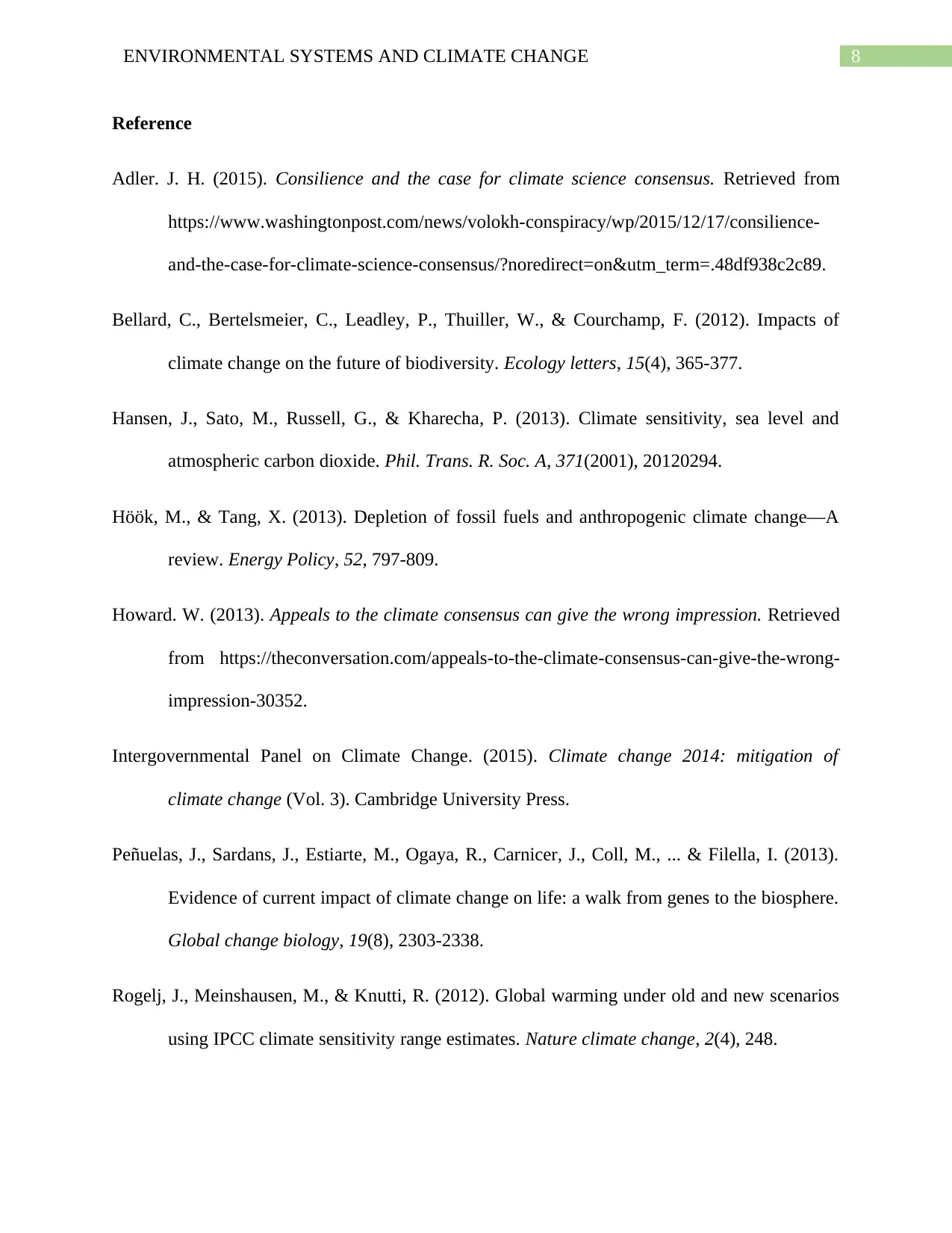
8ENVIRONMENTAL SYSTEMS AND CLIMATE CHANGE
Reference
Adler. J. H. (2015). Consilience and the case for climate science consensus. Retrieved from
https://www.washingtonpost.com/news/volokh-conspiracy/wp/2015/12/17/consilience-
and-the-case-for-climate-science-consensus/?noredirect=on&utm_term=.48df938c2c89.
Bellard, C., Bertelsmeier, C., Leadley, P., Thuiller, W., & Courchamp, F. (2012). Impacts of
climate change on the future of biodiversity. Ecology letters, 15(4), 365-377.
Hansen, J., Sato, M., Russell, G., & Kharecha, P. (2013). Climate sensitivity, sea level and
atmospheric carbon dioxide. Phil. Trans. R. Soc. A, 371(2001), 20120294.
Höök, M., & Tang, X. (2013). Depletion of fossil fuels and anthropogenic climate change—A
review. Energy Policy, 52, 797-809.
Howard. W. (2013). Appeals to the climate consensus can give the wrong impression. Retrieved
from https://theconversation.com/appeals-to-the-climate-consensus-can-give-the-wrong-
impression-30352.
Intergovernmental Panel on Climate Change. (2015). Climate change 2014: mitigation of
climate change (Vol. 3). Cambridge University Press.
Peñuelas, J., Sardans, J., Estiarte, M., Ogaya, R., Carnicer, J., Coll, M., ... & Filella, I. (2013).
Evidence of current impact of climate change on life: a walk from genes to the biosphere.
Global change biology, 19(8), 2303-2338.
Rogelj, J., Meinshausen, M., & Knutti, R. (2012). Global warming under old and new scenarios
using IPCC climate sensitivity range estimates. Nature climate change, 2(4), 248.
Reference
Adler. J. H. (2015). Consilience and the case for climate science consensus. Retrieved from
https://www.washingtonpost.com/news/volokh-conspiracy/wp/2015/12/17/consilience-
and-the-case-for-climate-science-consensus/?noredirect=on&utm_term=.48df938c2c89.
Bellard, C., Bertelsmeier, C., Leadley, P., Thuiller, W., & Courchamp, F. (2012). Impacts of
climate change on the future of biodiversity. Ecology letters, 15(4), 365-377.
Hansen, J., Sato, M., Russell, G., & Kharecha, P. (2013). Climate sensitivity, sea level and
atmospheric carbon dioxide. Phil. Trans. R. Soc. A, 371(2001), 20120294.
Höök, M., & Tang, X. (2013). Depletion of fossil fuels and anthropogenic climate change—A
review. Energy Policy, 52, 797-809.
Howard. W. (2013). Appeals to the climate consensus can give the wrong impression. Retrieved
from https://theconversation.com/appeals-to-the-climate-consensus-can-give-the-wrong-
impression-30352.
Intergovernmental Panel on Climate Change. (2015). Climate change 2014: mitigation of
climate change (Vol. 3). Cambridge University Press.
Peñuelas, J., Sardans, J., Estiarte, M., Ogaya, R., Carnicer, J., Coll, M., ... & Filella, I. (2013).
Evidence of current impact of climate change on life: a walk from genes to the biosphere.
Global change biology, 19(8), 2303-2338.
Rogelj, J., Meinshausen, M., & Knutti, R. (2012). Global warming under old and new scenarios
using IPCC climate sensitivity range estimates. Nature climate change, 2(4), 248.
⊘ This is a preview!⊘
Do you want full access?
Subscribe today to unlock all pages.

Trusted by 1+ million students worldwide
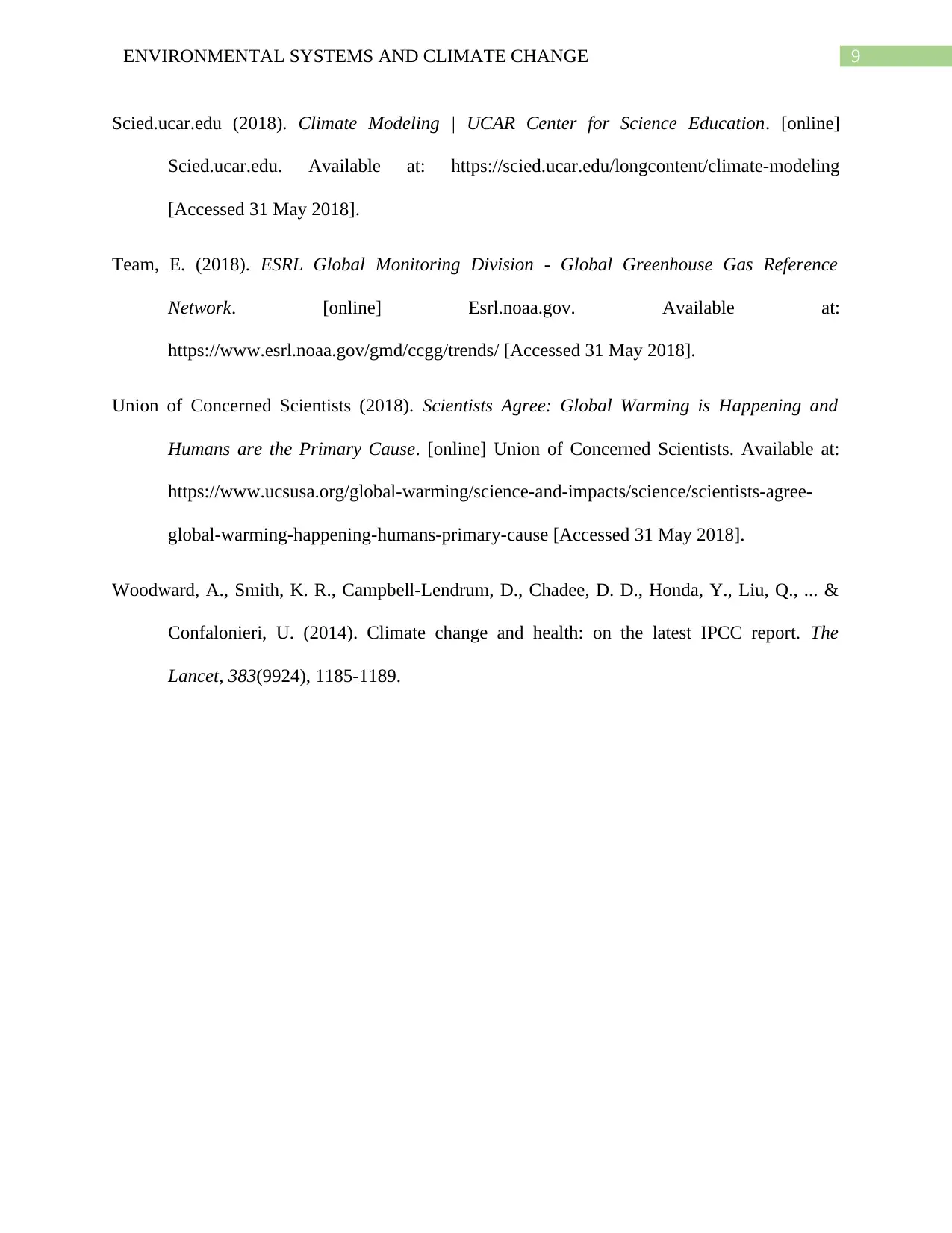
9ENVIRONMENTAL SYSTEMS AND CLIMATE CHANGE
Scied.ucar.edu (2018). Climate Modeling | UCAR Center for Science Education. [online]
Scied.ucar.edu. Available at: https://scied.ucar.edu/longcontent/climate-modeling
[Accessed 31 May 2018].
Team, E. (2018). ESRL Global Monitoring Division - Global Greenhouse Gas Reference
Network. [online] Esrl.noaa.gov. Available at:
https://www.esrl.noaa.gov/gmd/ccgg/trends/ [Accessed 31 May 2018].
Union of Concerned Scientists (2018). Scientists Agree: Global Warming is Happening and
Humans are the Primary Cause. [online] Union of Concerned Scientists. Available at:
https://www.ucsusa.org/global-warming/science-and-impacts/science/scientists-agree-
global-warming-happening-humans-primary-cause [Accessed 31 May 2018].
Woodward, A., Smith, K. R., Campbell-Lendrum, D., Chadee, D. D., Honda, Y., Liu, Q., ... &
Confalonieri, U. (2014). Climate change and health: on the latest IPCC report. The
Lancet, 383(9924), 1185-1189.
Scied.ucar.edu (2018). Climate Modeling | UCAR Center for Science Education. [online]
Scied.ucar.edu. Available at: https://scied.ucar.edu/longcontent/climate-modeling
[Accessed 31 May 2018].
Team, E. (2018). ESRL Global Monitoring Division - Global Greenhouse Gas Reference
Network. [online] Esrl.noaa.gov. Available at:
https://www.esrl.noaa.gov/gmd/ccgg/trends/ [Accessed 31 May 2018].
Union of Concerned Scientists (2018). Scientists Agree: Global Warming is Happening and
Humans are the Primary Cause. [online] Union of Concerned Scientists. Available at:
https://www.ucsusa.org/global-warming/science-and-impacts/science/scientists-agree-
global-warming-happening-humans-primary-cause [Accessed 31 May 2018].
Woodward, A., Smith, K. R., Campbell-Lendrum, D., Chadee, D. D., Honda, Y., Liu, Q., ... &
Confalonieri, U. (2014). Climate change and health: on the latest IPCC report. The
Lancet, 383(9924), 1185-1189.
1 out of 10
Related Documents
Your All-in-One AI-Powered Toolkit for Academic Success.
+13062052269
info@desklib.com
Available 24*7 on WhatsApp / Email
![[object Object]](/_next/static/media/star-bottom.7253800d.svg)
Unlock your academic potential
Copyright © 2020–2025 A2Z Services. All Rights Reserved. Developed and managed by ZUCOL.





